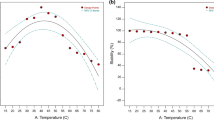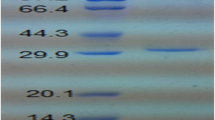Abstract
The stability of the mixed enzyme preparation Naringinase from Penicillium decumbens was studied in dependence of the temperature, the pH value, and the enzyme concentration by means of response surface methodology. Deactivation kinetics by formation of an intermediate state was proposed for fitting deactivation data. Empirical models could then be constructed for prediction of deactivation rate constants, specific activity of intermediate state, and half-life values under different incubation conditions. From this study, it can be concluded that (1) Naringinase is most stable in the pH range of 4.5–5.0, being quite sensitive to lower pHs (<3.5) and (2) the glyco-enzyme is a rather thermo-stable enzyme preserving its initial activity for long times when incubated at its optimal pH up to temperatures of 65 °C. Enriched α-l-rhamnosidase after column treatment and ultrafiltration presented similar deactivation kinetics pattern and half-life values as the unpurified enzyme. Thus, any influence of low molecular weight substances on its deactivation is most probably negligible. The intermediate state of the enzyme may correspond to unfolding and self-digestion of its carbohydrate portion, lowering its activity relative to the initial state. The digestion- and unfolding-grade of this intermediate state may also be controlled by the pH and temperature of incubation.



Similar content being viewed by others
References
Dunlap, W. J., Hagen, R. E., & Wender, S. H. (1962). Journal of Food Science, 27(6), 597.
Puri, M., & Banerjee, U. C. (2000). Biotechnology Advances, 18(3), 207–217.
Romero, C., et al. (1985). Analytical Biochemistry, 149(2), 566–571.
Young, N. M., Johnston, R. A. Z., & Richards, J. C. (1989). Carbohydrate Research, 191(1), 53–62.
Ellenrieder, G., & Daz, M. (1996). Biocatalysis and Biotransformation, 14(2), 113–123.
Mutter, M., et al. (1994). Plant Physiology, 106(1), 241–250.
Manzanares, P., et al. (2001). Applied and Environmental Microbiology, 67(5), 2230–2234.
Gallego, M. V., et al. (2001). Journal of Food Science, 66(2), 204–209.
Soria, F., & Ellenrieder, G. (2002). Bioscience Biotechnology and Biochemistry, 66(7), 1442–1449.
Meiwess, J., Wullbrant, D., & Giani, C. (1994) EP0599159.
Trummler, K., Effenberger, F., & Syldatk, C. (2003). European Journal of Lipid Science and Technology, 105(10), 563–571.
Mamma, D., et al. (2004). Food Biotechnology, 18(1), 1–18.
Manzanares, P., de Graaff, L. H., & Visser, J. (1997). FEMS Microbiology Letters, 157(2), 279–283.
Manzanares, P., et al. (2000). Letters in Applied Microbiology, 31(3), 198–202.
Monti, D., et al. (2004). Biotechnology and Bioengineering, 87(6), 763–771.
Scaroni, E., et al. (2002). Letters in Applied Microbiology, 34(6), 461–465.
Gabor, F., & Pittner, F. (1984). Hoppe-Seylers Zeitschrift Fur Physiologische Chemie, 365(9), 914–914.
Turecek, P., & Pittner, F. (1986). Applied Biochemistry and Biotechnology, 13(1), 1–13.
Tsen, H. Y., Tsai, S. Y., & Yu, G. K. (1989). Journal of Fermentation and Bioengineering, 67(3), 186–189.
Puri, M., Marwaha, S. S., & Kothari, R. M. (1996). Enzyme and Microbial Technology, 18(4), 281–285.
Norouzian, D., et al. (1999). World Journal of Microbiology & Biotechnology, 15(4), 501–502.
Biselli, M., Krugl, U., & Wandrey, C. (1995). In K. Drauz, & H. Waldman (Eds.), Enzyme catalysis in organic synthesis—a comprehensive handbook, Vol. 1 (pp. 89–155). Weinheim: VCH.
Klibanov, A. M. (1983). Advances in Applied Microbiology, 29, 1–28.
Bisswanger, H. (1999). Enzymkinetik: Theorie und methoden (3rd ed.). Weinheim: Wiley-VCH.
Sadana, A. (1991). Biocatalysis: Fundamentals of enzyme deactivation kinetics. New Jersey: Prentice Hall.
Bradford, M. M. (1976). Analytical Biochemistry, 72(1–2), 248–254.
Aktinson, C. (1992). Optimum experimental designs. Oxford: Clarendon.
Box, G. E. P., Hunter, W. G., & Hunter, J. S. (1978). Statistic for experimenters: An introduction to design, data analysis and model building. New York: Wiley.
Khuri, A. I., & Cornell, J. A. (1987). Response surfaces, design and analyses. New York: Marcel Dekker.
Rasch, D., Verdooren, L. R., & Gowers, J. I. (1999). Grundlagen der Planung und Auswertung von Versuchen und Erhebungen, R. Oldenbourg Verlag, München, Wien
BenoitMarquie, F., et al. (1997). Journal of Photochemistry and Photobiology A—Chemistry, 108(1), 65–71.
Oliveros, E., et al. (2000). In Proceedings of the third Asia pacific conference (pp. 577–581). Singapore, Work Scientific.
Oliveros, E., et al. (1997). Chemical Engineering and Processing, 36(5), 397–405.
NEMRODW LPRAI, B.P. no. 7, Marseille - Le Merlan, 13311 Marseille Cedex 14, France. Retrieved from www.nemrodw.com.
Scopes, R. (1994). Protein purification, principles and practice (3rd ed.). New York: Springer.
Mozhaev, V. V. (1993). Trends in Biotechnology, 11(3), 88–95.
Greco, G., et al. (1992). In Stability and stabilization of enzymes (Proceedings of an International Symposium) (pp. 429–435). Maastricht: Elsevier Science.
Prazeres, D. M. F., Garcia, F. A. P., & Cabral, J.M. S. (1992). In Stability and stabilization of enzymes (Proceedings of an International Symposium) (pp. 445–450). Maastricht: Elsevier Science.
Acknowledgments
The authors would like to thank the financial support of this project, carried out in the framework of a EU-CRAFT project (1999-72243) entitled “Integrated process for bio-surfactant synthesis at competitive cost allowing for their application in household cleaning and bio-remediation” (InBioSynAp). We also thank Rebecca Lorenz for her helpful practical input during the research project.
Author information
Authors and Affiliations
Corresponding author
Rights and permissions
About this article
Cite this article
Magario, I., Neumann, A., Oliveros, E. et al. Deactivation Kinetics and Response Surface Analysis of the Stability of α-l-Rhamnosidase from Penicillium decumbens . Appl Biochem Biotechnol 152, 29–41 (2009). https://doi.org/10.1007/s12010-008-8204-5
Received:
Accepted:
Published:
Issue Date:
DOI: https://doi.org/10.1007/s12010-008-8204-5




